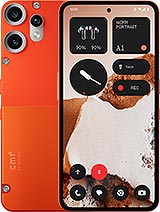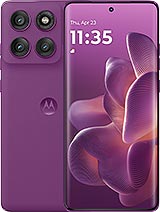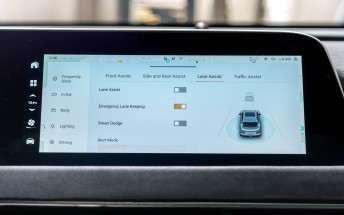This is why your phone doesn't have a matte display

Oh, the age-old clash of glossy versus matte displays – a topic igniting more late-night forum firestorms than a viral tech rumor.
In the glossy-dominated world of smartphones, it's like finding a unicorn when a manufacturer dares to deviate. Enter the rare spectacle: the TCL 40 NxtPaper 5G with its matte LCD. It's not just a phone; it's a 'what if' wrapped in a sleek, pocket-sized package.

The smartphone world has seemingly settled on glossy displays, so we hardly have a choice now, do we? We don't even know if having a matte display on your phone is any cooler, unlike with laptops or monitors where you could see both options IRL and decide for yourselves.
The TCL 40 NxtPaper 5G is here to lift that veil for us. Let's dive into this rare gem and see what it's like to break free from the glossy norm and whether it's something we've all missed out on.
What makes the TCL 40 NxtPaper 5G special?
The TCL 40 NxtPaper is an experimental device - an attempt to offer a screen that looks paper-like in a smartphone. It's full color if you want it to be; it can play videos too. But switch to the right mode, and it will look like a Kindle's screen (okay almost). Our point is that it's great for both for multimedia and for book reading. In doing so, however, it's less than stellar in either thing. Before we explain, here's a refresher on the phone's specs.
TCL 40 NxtPaper 5G specs at a glance:
- Body: 164.5x75.4x9.0mm, 192g; plastic back.
- Display: 6.60" LCD, 90Hz, 500 nits, 720x1612px resolution, 20.15:9 aspect ratio, 267ppi.
- Chipset: Mediatek Dimensity 6020 (7 nm): Octa-core (2x2.2 GHz Cortex-A76 & 6x2.0 GHz Cortex-A55); Mali-G57 MC2.
- Memory: 256GB 6GB RAM; microSDXC (uses shared SIM slot).
- OS/Software: Android 13, TCL UI.
- Rear camera: Wide (main): 50 MP, f/1.8, 1/2.76", 0.64µm, PDAF; Macro: 2 MP, f/2.4; Depth: 2 MP, f/2.4.
- Front camera: 8 MP, (wide), 1/4", 1.12µm.
- Video capture: Rear camera: 1080p@30fps; Front camera: 1080p@30fps.
- Battery: 5000mAh; 15W wired.
- Connectivity: 5G; Hybrid Dual SIM; Wi-Fi 5; BT 5.1; NFC; FM radio; 3.5mm jack.
- Misc: Fingerprint reader (side-mounted).
First things first - what is the display technology used by the TCL 40 NxtPaper 5G? Officially published specs are vague at best so they can easily confuse someone, whether intentionally or not.
The official marketing for the phone calls its display a "Full-color Electronic Paper Display". This immediately brings up associations to the e-Ink display technology as seen in e-book readers like the Amazon Kindle line.
If you are not familiar with the tech, it is incredibly fascinating and involves actual particles moving back and forth through capsules in different layers of the display in order to produce an image. Sometimes, even a color one. Said image is then semi-permanent and does not require current to keep on the display, nor does it technically require a backlight to be properly visible. To set the record straight, this phone does not have that type of display.
To make things even more confusing, in the past, TCL has demoed e-Ink based products under the NxtPaper brand so they definitely had us as "Full-color Electronic Paper Display" at first.
 Left: Color Ink pode • Right: Normal node
Left: Color Ink pode • Right: Normal node
The illusion of an e-Ink display almost immediately evaporated when we started using the device and noticed the way the image looks, the fact that it definitely relies on a backlight and that it has none of the slow refreshing hurdles of e-Ink. On the contrary, the TCL 40 NxtPaper 5G panel refreshes at up to 90Hz.

Our best guess is that the TCL 40 NxtPaper 5G uses an LCD with some clever additional layers on top, which allow it to produce a great-looking monochrome image to go along with the sublime matte finish. This finish really feels great under your fingers though it's nowhere near paper-like.
Glare and reflections
There are many ways to achieve a matte look, and not all matte displays are the same level of matte. Typically, a 24-28% haze value is applied to a traditional matte display. Its purpose is to scatter the light coming in from the surroundings and diffuse it instead of reflecting it back to the user. The light still has to go somewhere, so it is scattered rather than reflected. In essence, you are trading direct reflections for light diffusion.
This leads us to Reason 1 why you don't want a matte display on your phone. A matte display like the one on TCL 40 NxtPaper 5G does not have the same optical clarity as glossy ones.
 Left: Xiaomi Poco C65 • Right: TCL 40 NxtPaper 5G
Left: Xiaomi Poco C65 • Right: TCL 40 NxtPaper 5G
The lack of optical clarity is not helped by the fact that the TCL 40 NxtPaper 5G LCD doesn't get overly bright either. We measured around 492 nits by maxing out the manual brightness slider. An automatic brightness boost mode can kick up that figure to around 611 nits, which is still not terribly impressive. It's decent for an LCD but not impressive.
We also tested the TCL 40 NxtPaper 5G at its minimum brightness to see how comfortable it is at night. We weren't impressed by the 5.5 nits, or so the backlight still puts out even in its lowest brightness setting.
Still, taking a look at the TCL 40 NxtPaper 5G next to the Xiaomi Poco C65 - a recent LCD phone with a glossy screen and a similar max brightness to the TCL, we do notice an improvement in reflections and glare. So, the matte finish is doing its job.
 Left: Xiaomi Poco C65 • Right: TCL 40 NxtPaper 5G
Left: Xiaomi Poco C65 • Right: TCL 40 NxtPaper 5G
It has to be said that manufacturers are not without options for battling glare even on glossy screens. AU Optronics, for instance, has a semi-glossy coating for their VA panels, which features only 13-18% haze value. Samsung also has its own 'very light matte' surface on some VA panels that has an 18% haze value. You'll also find glossy screens with anti-glare (low 1-4% haze) or anti-reflective treatments. So, middle grounds do exist.
And perhaps the best alternative approach to battling glare and reflectivity is to "punch through" it with high enough brightness. This is the primary reason why modern displays, particularly flagship ones, strive for higher and higher brightness values with each generation. It is why said phones will oftentimes go out of their way to include an automatic brightness overdrive mode that only triggers when bright conditions are detected and is so aggressive that it can't usually be sustained for long. All of this is in an effort to improve the display's legibility by simply having the display be the brightest source of light around.
As you will see below, adding a modern flagship OLED glossy-screen device to the comparison - the Galaxy S23 Ultra with its 1274 nits of max brightness in this case, makes it apparent that even a glossy screen in the higher segment is superior. There is no substitute for simply having more brightness to work with when battling glare and reflections.
 Left to right: Samsung Galaxy S23 Ultra, Xiaomi Poco C65, TCl 40 NxtPaper 5G
Left to right: Samsung Galaxy S23 Ultra, Xiaomi Poco C65, TCl 40 NxtPaper 5G
Colors and contrast
But even though you will be getting apparent benefits of the matte screen in the midrange regarding glare and reflections, you have to know that having a matte display is noticeably detrimental to colors. This leads us to Reason 2 why you don't want a matte display on your phone. Colors are nowhere as vibrant. Contrast suffers as well. Darks take a particular hit and can't look deep and inky. At least not as much as on an equally midrange glossy display.

This is true of the TCL 40 NxtPaper 5G as well. Its color palette is pretty washed out overall. None of the color modes are particularly color-accurate. All of them seem to target the sRGB color space but fail to get accurate reproduction with deltaE values as high as ten and a noticeably cold and blue hue.

However, the really interesting color modes are housed inside their own NxtPaper mode menu and are TCLs' attempt at imitating the look and feel of an e-Ink display. As its name suggests, the color paper mode has colors, though these are incredibly muted, even more so than the normal color modes of the display. Contrast is particularly low, too.

Next among the NxtPaper modes is the Ink Paper mode, which is fully monochrome and has a pretty white and neutral backlight color to it.

We have to say that at least at first glance, you could easily mistake the LCD for an e-Ink unit with that well-made monochrome mode with a nicely white backlight and this matte display, which is an achievement by TCL in itself. TCL claims that this is all done to facilitate reading and make it easier on the eyes. While we can't guarantee that the TCL 40 NxtPaper 5G doesn't still have a display shim in the backlight or excessive blue light, we can say that subjectively, it feels a bit more comfortable to look at the display and especially read on it, compared to a conventional glossy LCD.
But as explained above, that comes at the expense of color reproduction. You don't plan on using your phone in monochrome mode all day long, right?
Image sharpness
Image sharpness is another common issue with matte displays. This is mostly due to the fact that the matte surface scatters and diffuses both light coming from your surroundings as well as that coming from the display itself. This means that due to light refractions, straight lines simply don't look quite as straight and are a bit "fuzzy" instead. This is particularly noticeable on smaller text fonts and is not ideal for something marketed as a reading-centric device.
And this leads us to Reason 3 why you don't want a matte display on your phone. It just doesn't look as sharp as a glossy screen.
The grain of the matte surface is particularly annoying on solid colors. It doesn't really help that the resolution of the TCL 40 NxtPaper 5G is only HD+ (720 x 1612 pixels). That is stretched relatively thin on a 6.6-inch 20:9 diagonal, which results in a pixel density of around 267 ppi. Perhaps the 4G version of the phone will look a bit nicer since it has a FHD+ display instead.
Just to clear up some potential confusion, optical clarity and image sharpness are not exactly the same thing, so we list both here as separate points. Optical clarity, in this case, is a property of the surface covering the LCD, while image sharpness refers to the perceived sharpness of the resulting image. As such, this is more of a subjective composite property of the image that is, indeed, greatly affected by the optical clarity of the display but is also dependent on many other factors, such as resolution and the resulting pixel density.
Final thoughts
While definitely a nice curiosity, we don't really see ourselves recommending a phone with a matte screen to the casual user and this extends to include the TCL 40 NxtPaper 5G. The matte display looks impressive in its own right, but in our opinion, it doesn't offer enough benefits to outweigh the various drawbacks of the technology. Plus, as a whole, the phone itself isn't particularly impressive.

We really don't see matte displays becoming a thing any time soon, and for good reason. The way we see it, the current approach of battling reflections and glares by pushing higher brightness levels, plus modern anti-glare coatings, is much better overall. You get much more vibrant colors, much better contrast and overall sharpness on a glossy display, all of which are arguably more valuable to consumers.
Reader comments
- fertolero
- 18 Jan 2024
- gxe
i have one the 4g variant and you missed out saying that it really protects the eyes agaisnt blue light and its the only smartphone to have the certification from an independent entity ... tvu rheinland certified low blue light and tvurheinland certi...
- Spike
- 29 Dec 2023
- b1E
So TCL is experimenting with a very low and cheap screen for Matt!? How about try: 4K, 1500 nits at least , other smart AI processing light etc and then we can talk!? The problem with increasing brightness to combat glare on glossy acreens is it...
- Anonymous
- 18 Dec 2023
- qNG
You reviewed an off-brand phone with unknown screen tech and concluded all matte screens are bad. Come on.





 Nothing
Nothing Samsung
Samsung OnePlus
OnePlus Motorola
Motorola Xiaomi
Xiaomi


